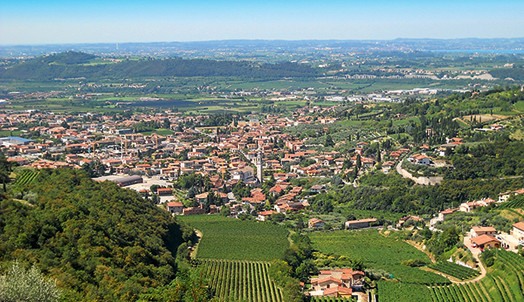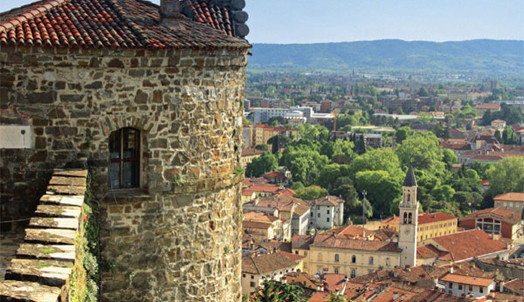Generally speaking, people who study wine are mentally prepared for the ‘Long March’ – knowing that wine knowledge is complicated and difficult to learn, and the variation of wine styles are endless (isn’t this one of the reason that restricts the spreading of wine in China?) – but still, there are many that give up before they even see the first glimmer of success.
I think wine students would all agree with me: although wine is difficult to learn, Italian wine is even harder!

So how difficult can Italian wine be? At a dinner organised by the Italian Ambassador in China, the guests were talking about their understanding of Italian wines. When it was my turn, I said, ‘during my two-year stay in France studying wine, I never arranged a trip to Italy, because French wines are the best example for beginners to learn about wine, and two years' time was not enough.
‘After I completed my study there and went back to China for another two-year study, I finally built enough courage to start to learn about Italian wines, and took my first trip to the Italian wine regions. Italian wines are too abundant and too complicated; one should not start to learn Italian wines before gaining some basic wine knowledge, otherwise he/she will not be able to persist without a tremendous amount of confidence.’
The reserved Ambassador Riccardo Sessa made a movement of drawing a gun from his waist and said jokingly, ‘now I understand what you want to say – I was thinking of drawing my gun a moment ago.’ Of course he was kidding, but what I said was my true feelings about Italian wines. With the entire wine world in front of me, I cannot favour one country more than another.
The richness of Italian wines is firstly thanks to the long history of winemaking in this country. Different grape varieties were widely planted across the country in thousands of years’ time; they expressed the characteristics of different terroir and formed the diversity of Italian wines.
The diversity of Italian wines is also thanks to the creativity of the Italian people: they have producers who voluntarily gave up their DOC status in order to break away from the restrictions and show their own personalities. It was this eclectic spirit that created the Super Tuscans.
I have experienced how Italian wines are complicated myself many times. In May 2008, I went to work at a Catholic University in Piacenza for a short time. Professor Luigi Bavaresco who received me always took me to the wineries in the surrounding areas. It was the central area in the mid-north part of Italy. Although it wasn’t famous as a wine region, the visit to La Stoppa, which is located in the Trebbia Valley in Piacenza, left a strong impression on me. I tasted a few 2003 wines during the visit, and they had a clear sweet taste in the mouth and felt like the fermentation wasn’t complete.
Elena Pantaleoni from the winery said calmly, ‘that’s correct. This was supposed to be a dry wine, but it was a hot year and the sugar level in the fruit was very high, so the fermentation naturally stopped before the fermentation completed. We didn’t restart the process, and left it as a distinguishing feature of the vintage; our consumers were happy about this as well.’
If you want to be familiar with Italian wines, you also need to remember those long names of places and grape varieties. The diversity of grape varieties the Italians are proud of is definitely a nightmare for those who study Italian wines. After you manage to remember those grape varieties and want to do further research of the variety characteristics, you might find out that the different grapes growing in different regions could be the same variety with different names! How can you confirm if they are the same or not? Probably only the researchers can tell for sure, because many of the documents do not match up to each other.
Fortunately, this is no longer a problem. The publication of Italian Wine Grape Varieties – Their Viticultural Characterization has made the study of Italian wine grapes much easier than before. This bilingual book (Italian-English) includes the main results of a three year research program funded by the Ministry of Agriculture, Food and Forestry (MiPAAF), entitled ‘Viticultural Characterization of the main Italian Grape Varieties and their Terroir’ (acronym VIGNETO). As the former director of the Conegliano Viniculture Research Centre, Professor Luigi Bavaresco is one of the authors of the book and the co-leader of the program.
The project selected and investigated 51 autochthonous grape varieties using DNA resequencing, metabolomic profiling of grapes at harvest, and transcriptomic and epigenomic approaches for a subset. The project also involved the study of genotype-environment interactions to understand the role of pedo-climatic factors on grapes composition and wine sensory profiles.
The book is organized in chapters for each specific research methodology applied, explaining the goals and the obtained results, and a brief ampelographic descriptions of each of the 51 grape varieties.
For example, the first grape variety in the book is Aglianico. This is a variety introduced to Southern Italy from Greece a long time ago, and is said by Denis Dubourdieu to be ‘probably the grape variety with the longest consumption history in the world’. The book said that Aglianico was registered in 1970, currently has 19 strains, and has several official alternative names including Glianica, Glianico, Ellanico and Ellenico. Moveover, it also lists the ‘recommended, suitable and official approved’ growing areas, and the three DOCGs for Aglianico in the approved areas: Aglianico del Taburno, Aglianico del Vulture Superiore and Taurasi. This is very clear, isn't it?
The text is written in non-technical style, so that the readers will understand the practical implications of the research, even though in some cases these findings will not be immediately transferable into a vineyard or winery. An appendix reporting on the surface area covered by the main wine grape varieties in Italy from 1970 onwards is also included. Moreover, the book is enriched by a set of auteur photos not strongly linked to the text but aiming at stirring up emotions through a layout that emphasizes the artistic peculiarities.
Additional reading: some Aglianico wines LI Demei tasted in 2015
Aglianico is not a new grape variety to me, but the first time I talked about its viniculture and winemaking characteristics with the producer face to face was in April 2015 at the Grace Vineyard in Shanxi Province.
The viticulturist, WANG Hui, told me that the Grace Vineyard started to experiment growing Aglianico in 2006. Among the red varieties, this one has a quick véraison process and ripens relatively early, so it is harvested in mid-September. The yield is similar to Cabernet Sauvignon with medium growth. The plant has average resistance to downy mildew, but stands against other diseases well. In that visit, I had the opportunity to taste two vintages of Aglianico that hadn’t yet been labelled.

Grace Vineyard, Tasya's Reserve Aglianico 2012
This is Grace Vineyard’s first vintage of Aglianico. It is ruby red in colour, lighter than Marselan and Cabernet Sauvignon; the smell is fresh and refreshing, with plum and red fruit flavour on the palate, and sometimes a herb and smoky taste; medium body, light, balanced, lively and clean.
Grace Vineyard, Tasya's Reserve Aglianico 2013
Harvested a few days earlier than the year before, dark purple in colour, but still lighter than the Marselan from the same vintage; fresh red fruit on the nose with slight roasted nuts, dry leaves and some yeast scents; medium body, well-balanced and has tight tannin.
Apparently, if you like the heavy ‘fruit bomb’ style, this is not your variety. However, if you are tired with Cabernet Sauvignon and Merlot, and looking for something with new ideas, Aglianico is not a bad choice, with both the history of the variety and the taste quality of the wine.
In July in the same year, I attended a trip organised by Istituto Grandi Marchi to visit the wine regions in Southern Italy. We tasted some classic Aglianico at Mastroberardino in Campania. The Mastroberardino family is the guard of Italian viticulture, and it has been ten generations since the winery was founded. They are holding the ground of the growth of several classic Italian varieties including Aglianico in Southern Italy. They never gave up even when the Phylloxera struck Europe, or during the wars and the economic depression, so today’s consumers could have the chance to enjoy various styles of wines.
Radici Taurasi Riserva DOCG 2007
Clear ruby red in colour; on the nose it is fresh, with cherry, animal, leather, dried fruit smell; lively in the mouth, with good acidity, medium body and a long and clean finish. Although it doesn’t look intense, the acidity and tannin on the palate shows good aging potential.
Radici Taurasi Riserva DOCG 1997
Clear, bright and red-brown in colour; reserved on the nose, with tobacco, liquorice and some balsamic vinegar flavour; lean on the palate, sweet and round mouth feeling, light-bodied, with delightful finish.
Translated by Nina Fan Feng / 冯帆
All rights reserved by Future plc. No part of this publication may be reproduced, distributed or transmitted in any form or by any means without the prior written permission of Decanter.
Only Official Media Partners (see About us) of DecanterChina.com may republish part of the content from the site without prior permission under strict Terms & Conditions. Contact china@decanter.com to learn about how to become an Official Media Partner of DecanterChina.com.











Comments
Submit